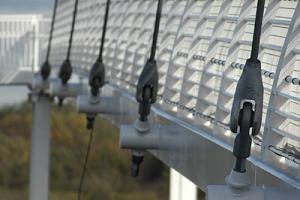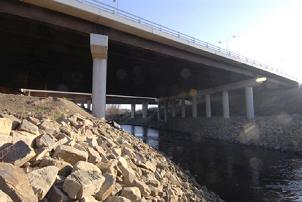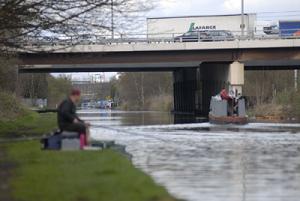M60 Junction 5–8 Widening |

82.4% |
Project Team:
Client: Highways Agency
Client Representative: Mouchel Parkman
Designer:
Halcrow
Contractor:
AMEC –
Alfred McAlpine (acquired by Carillion) : Joint Venture
Project background
This complex £139.5m scheme provides additional capacity in the south west quadrant of Manchester’s orbital motorway, reducing delays, easing congestion and improving safety. The scheme’s construction programme was designed around the traffic management phasing in order to minimise disruption and keep the 116,000 vehicles per day moving through the works.
The scheme required the construction of 16 new bridges, 24 pre-cast concrete portal sign/signal gantries and several reinforced-earth retaining walls together with the demolition of 11 original bridges and 23 sign gantries.
Extensive landscaping and planting has softened the impact of the scheme on the local environment and replaced areas of vegetation and public open space, which were lost to the construction works. The opportunity was taken to reduce road traffic noise by providing screen mounds and fences.
A Grade II listed dovecote (at Junction 6) was taken down brick by brick before the works started; this has since been renovated and re-erected in a local park
Project management approach
By adopting a partnering approach for this project, risks were identified early and shared by agreement, and disagreements during the works were resolved more quickly. It also strongly promoted a more ‘open’ style of management both in financial matters and in practice, on site.
 |
|
The environment
One of the most significant improvements has been the substantial reduction in noise levels adjacent to the motorway corridor. This has been achieved by building large earth screen mounds planted with trees and shrubs, with some having a noise attenuation fence on the crown. In other areas noise fences have been installed at the motorway boundary. In addition, the new carriageway surfacing is constructed from a thin layer of ‘quieter’ asphalt to significantly reduce tyre noise.
Other benefits have also been realised, including:
- Areas of land were acquired to enable lost wildlife habitats to be recreated.
- These areas have become valuable refuges for flora and fauna.
- Access to public open space and amenities has been improved through the addition of better footpaths, cycleways and bridleways, including some 'landmark' bridges.
- Twelve drainage outfalls were approved by the Environment Agency, all having interceptors to capture oil and other liquid spillages on the motorway carriageways, before they reach the River Mersey.
- Liaison with the Environment Agency has ensured that the scheme design has not adversely affected the surrounding hydrology. Reinforced concrete bored piles were used to found structures on contaminated ground to seal off any pollution leakage.
- Provision of more areas of improved public open space to benefit the local community.
- Planting of 126,000 new trees.
 |
|
Landmark footbridges
The scheme features a pair of white 'landmark' cable-stayed bridges, one between Junctions 5 and 6, providing access to the amenities at Trafford Water Park and areas of public open space, and the other between Junctions 7 and 8, carrying the Trans Pennine Trail through the Mersey Valley. These bridges also allowed the closure of the old underpasses which people originally used to cross under the motorway.
Demolition of bridges and sign gantries
Most demolition works were carried out overnight, during full closures of sections of the motorway, with fully signed diversion routes in operation.
Advance publicity explaining the diversion routes and signing, and the co-operation of the travelling public and the emergency services ensured that inconvenience was reduced as much as possible.
Waste concrete was recycled by crushing to uniform size and used in construction of the new carriageway. The steel was separated out and sent for recycling
 |
|
Explosive demolition
Removal of the Mersey South Slip Road Bridge and the Mersey South main carriageway bridge at Junction 7 were carried out by means of two controlled explosive demolitions at night. The detonation sequence was controlled to minimise the quantity of debris entering the River Mersey.
Local residents and the press were informed about the programme for the demolition. The explosions provided a considerable spectacle for the hundreds of spectators who came to watch.
Minimising disruption
Relocating services included using directional drilling techniques underneath Junction 7 and the A56 Chester Road, to avoid open-cut trenches that would have caused severe traffic disruption and delays
 |
|
Respect for the local community
The contractor erected areas of environmental screening in several locations, to ensure that properties and amenities were shielded from disruption during major elements of the construction process.
Consultation and liaison between the Highways Agency, local residents, local authorities and their elected representatives began soon after the scheme entered the National Roads Programme in 1990 and continued through the Public Consultation and Public Inquiry in 1995. The scheme design was modified where appropriate following these consultation exercises.
When construction of the scheme was started in 2003, the contractor ensured that this close liaison continued as the design and construction progressed on site.
The Highways Agency was pleased that the level of complaints from the public during the three years of the construction was very low for such a large construction project. Public relations were a priority, with two major exhibitions being held and four newsletters published.
Additional projects benefiting the local community included improvements to an animal sanctuary and rejuvenation works to a fishing lake.
The team always adopted a 'customer first' attitude when contacting members of the public, landowners, interest groups, resident groups and their elected representatives when issues arose, and responded immediately to telephone calls, letters, emails and requests.
Everything possible was done to minimise the impact of the works over the three years, and where noise and disruption were unavoidable, it was undertaken as quickly and safely as possible.
 |
|
